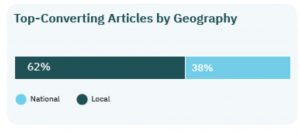
How do you determine the ideal length for your videos to keep viewers engaged?
A bit of research on the topic pulls up answers stating that the perfect video length is everything from two to five minutes to 10 to 12 minutes to a strict “no more than two minutes.”
What is best practice? What should be the ideal video length?
Let’s take a look.
How Long Should Videos Last?
To some extent, the length of your videos should depend on what kind of videos you’re producing.
Are you looking to put together an “about” video, testimonial videos or product videos? Or are you interested in creating a weekly feature, like an industry update video?
According to HubSpot, 5 percent of viewers stop watching a video after one minute and 60 percent by two minutes.
While weekly features can be longer, most business-heavy videos should be under two minutes if you want to hold the viewer’s attention for the duration of the content. Evidence suggests there is significant drop-off in viewership if it’s any longer.
Some viewers will stay longer, but if that’s the direction you choose, you’ll need to front-load your videos with the most important content. If the most critical points are at the middle or at the end of the video, most of the people watching your video will have missed those key points.
But there are alternative opinions on the subject. TJ Walker, CEO of Media Training Worldwide, suggests that the length of your video should be contingent on how long it takes for you to share your message. He raises the example of Gary Vaynerchuk of Wine Library TV, who was immensely successful producing 10-to-30-minute videos.
By his own admission, however, he says that most videos he produces tend to be in the 60-to-90-second range, and also points out that you can split longer videos into several parts (for example, Part 1, Part 2, etc.).
Where Should You Publish Your Videos?
More than likely, you are already aware of sites like YouTube and Vimeo, which offer a lot of data and insights into viewer behavior. But new video-sharing sites are popping up all the time, and services like Wistia offer you more control over the presentation of your content.
If that wasn’t enough to consider, short-form video content is also on the rise, with apps like Snapchat, Instagram and Vine leading the way.
Where should you publish your videos? What criteria do you use to determine where to build your presence?
Here are some tips:
- Consider your resources. Do you have the necessary resources—personnel and monetary—to publish your video across multiple platforms?
- Determine how much exposure you want. In theory, publishing to more channels will give you more exposure. But it might cause more displacement (for example, your video could get a total of a million views across multiple sites, though it could have gotten the same amount on a single site).
- Publish where your audience is. You should know where your audience hangs out online already. Consider this data as you make a decision about which sites to publish to.
Should I Start a YouTube Channel?
For most businesses, the answer will be yes. From GoPro to Nintendo, plenty of brands and businesses have strong presences on YouTube. YouTube videos are searchable in Google, which means there’s a significant SEO benefit to uploading your content to YouTube, and its user base is more than 1 billion, which should tell you that members of your target audience are almost certainly there.
But there are some downsides to YouTube. The platform only unlocks certain features for users after they’ve verified their channel or reached certain milestones. The site is saturated with content—500 hours’ worth of video is uploaded to YouTube every minute. Advertising volume on YouTube has also increased, distracting users from the content they’re trying to view.
If you’re depending on YouTube—or for that matter, any site—to supply you with views and traffic, you’re not going to get the best ROI on your videos. Part of your promotional strategy should include steps you can take to syndicate and promote your videos so they actually get viewed.
Get Your Videos Out Into the World
Despite the changes that have happened over the years, video marketing remains a powerful medium to generate leads, attract customers and increase engagement. Video gives your prospects an opportunity to get to know you, and more than ever, people are looking to connect with genuine, authentic businesses. The only difference now is that it’s harder to stand out from the crowd—cutting through the noise needs to be a part of your strategy.
Digital & Social Articles on Business 2 Community(90)
Report Post





